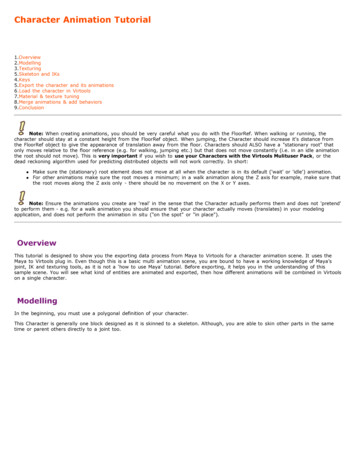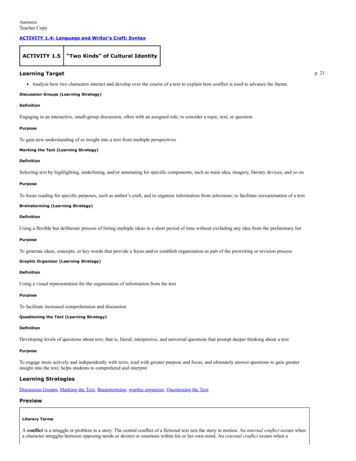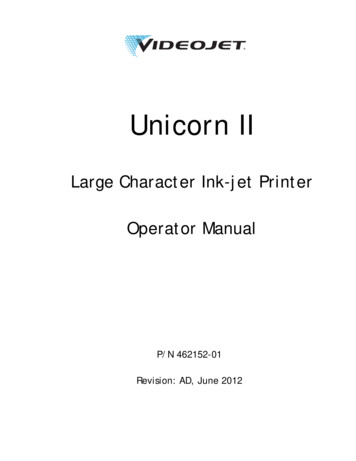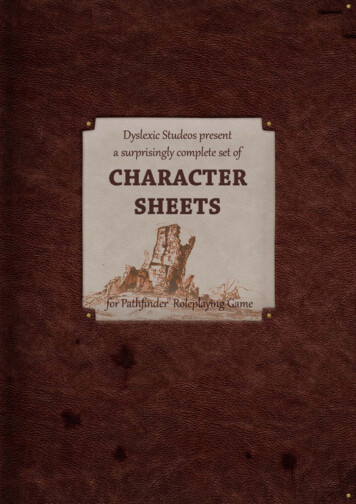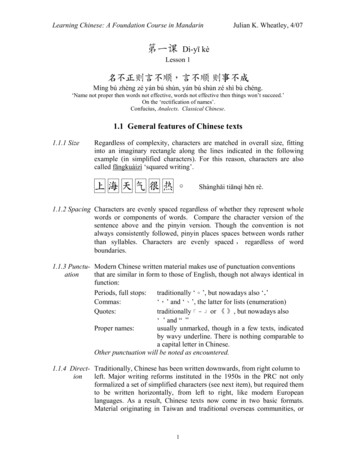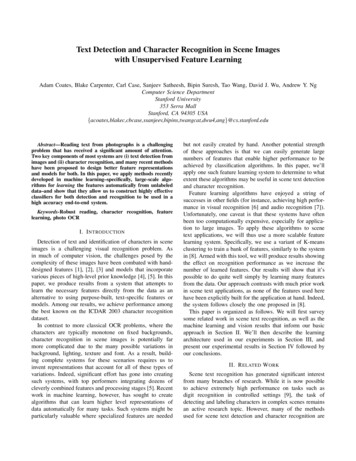
Transcription
Character, Actor, StarCh. 3 Building Narrative
Character, Actor, Star Centrality of characters to TVnarratives and structures Continuing existence of charactersbeyond the text are imagined through‘stars’ and ‘star texts,’ as actorsappear in other media texts. Performance of Actors & ActingStrategies
Building Characters Easy to mistake TV characters for real people with real livesbeyond TV. Programs work to hide or make invisible the construction thatgoes into creating characters. How are characters manufactured, and how to we understandmeanings associated with particular characters? Character Signs: (Richard Dyer) all those aspects of a characterthat communicate his/her nature and personality to the viewer.We interpret these signs according to 1) Our understanding ofthe world; 2) The context/program/genre in which the characterappears; and 3) The viewing situation. Codes of Character Construction: Conventions of costuming andprops often seem most ‘invisible’ to ordinary viewers, but theseconventions are historically & culturally defined, and ourconnotations for various signs change over time (p. 58).
A Typology of Character Signs Viewer Foreknowledge Character Name Appearance Objective Correlative Dialogue Lighting and Videography or Cinematography Action
Viewer Foreknowledge &Character Names Trailers and Advertisements Parent Programs generate Narrative Image Credit sequences rehearse character relationships. Names can be used to indicate relationships betweencharacters. Names can also be used to invite connotations (withethnic/religious stereotypes, character traits, etc.).
Appearance 1) Face (and Hairstyle); 2) Body (build & posture); 3)Costuming. Close-up and Facial Expressions (indeterminate meaningsindicating emotion). Characteristics become distinct as they differ from theprescribed ‘norm.’ These variations create meaning and caneven become cultural symbols (hairstyles). Actor physiques and gestures. Costumes: Code of dress predominant in a specific culture at aspecific time. Code of dress specific to television and television genres.
Objects, Dialogue, Lighting/Videography & Action Objective Correlative: an object or animal that is associated witha character and conveys something about him/her. These mayinclude the character’s environment or props. Dialogue: infer information about characters as it is revealedthrough conversations. Lighting: lighting from below makes actors look sinister, lightingfrom behind creates a mysterious silhouette. Lighting createsconnotations for characters. Camera Lenses: influence character development throughtechnical manipulation, which can distort or show characters inmany different ways. Action: Characters understood through their actions withinnarrative logic.
Building Performances Typology of Performance Signs: Vocal Facial Gestural Corporeal These signs construct characters’ emotions.
Vocal Performance Volume: Loud/Soft (connotativemeanings may vary). Pitch: The highness/lowness of a note.Interpretations of pitch tend towardgender-oriented meanings. Timbre: The quality of the vocal tone. Rhythm of Speech
Facial, Gestural andCorporeal Performance Facial Performance: how actors use facialexpressions to construct characters. Codes of gesture carry connotative meaningsthat vary over time and from culture toculture. Corporeal performance: how the entire bodyis utilized to convey a character’s personality.
Strategies of Performance Naturalistic: Repertory Method Non-Naturalistic Vaudeville Performance Brechtian Performance
Repertory Performance Developed within theater troops that would perform a series ofplays with the same group of actors. Actors constantly assume new roles by selecting gestures anddialects to construct a performance. Work of the actor is to study human movement and speech,borrowing gestures and dialects from life in constructingcharacters. Repertory actors are dispassionate in thisassemblage of actions and accents. They signify throughmovements and gestures (not their own emotional investment). Body language norms shift over time and between cultures.
Method Performance Method acting encourages the actor to ‘become’ the character,fusing his/her personality with the role. Once the actor fully embodies the role, the Method approachassumes that the gestures and dialect will grow organically out ofthis process. Emotional Memory: actors draw upon memories from previousemotions to match the emotions of the character. Sense Memory: remembering the physical sensations of aparticular emotional event to generate emotional performance. Improvisation: method of entering the ‘mind’ of a character. Constantine Stanislavski; Lee Strasberg; James Dean, MontgomeryClift, Julie Harris, Marlon Brando. It is impossible to discern the acting technique used from watchinga performance. Relationship to Freudian Psychological theories, preference formelancholy emotions, and often generated quirky, distinctiveperformances.
The Non-Naturalists “Faking It” Actors separate themselves from theroles they play and point to themechanics of their performances. Actors using non-naturalistic stylesdon’t become characters, they justpresent them to us, as though quotingthe character.
Vaudeville Performance Built around song-and-dance numbers, comedy routines,tableaux, and short dramatic skits. Vaudeville does not demand that we forget the presence of theactor within the guise of the character. Frequently remindviewers that characters are not real people. Direct Address acknowledges and involves the audience,breaking “4th wall” continuity. Vaudeville influenced TV Variety Shows until the 1970s, andcontinue to influence the styles of sketch comedy and late-nighttalk shows.
Brechtian Performance What ought acting to be like?“Witty. Ceremonious. Ritual. Spectator and actor ought not toapproach one another but to move apart. Each ought to moveaway from himself. Otherwise the element of terror necessary toall recognition is lacking” -Bertold Brecht Viewers should not identify with the characters, but achievedistanciation. Viewers do not become immersed in the narrative unknowingly,but instead are confronted by the construction of theperformance and thus alienated from the characters. As a Marxist theorist, Brecht believed that theater should pointout social ills and prompt spectators to take action, advocatingrevolutionary theater.
The Star System Star Image Texts & Intertextuality Promotion Publicity Television Programs Criticism
Star Image: Texts andIntertextuality Star Image: actors/personalities whose imagecirculates through culture in a variety of media. Star as Text: We must recognize the illusion ofintimacy and read stars through their mediaappearances as texts to be interpreted. Our knowledge of stars comes from an assemblage ofmedia texts, lending polysemy to any star’s image. Stars are featured intertextual, whereas actors do notdevelop a presence beyond their programs. A star’s intertextual presence is developed throughpromotion, publicity, television programs (and films),and criticism of programs.
Promotion Generated by stars and their representatives,including advertisements, appearances ontalk shows, and other industry-controlledmedia outlets. Most promotional texts place stars in thecontext of their TV characters. Stars and their images are more central toprime-time than to daytime TV.
Publicity Often indistinguishably intertwined with promotion. Information circulating about a star that is beyondhis/her control (news reports about scandals,unofficial biographies, unauthorized interviews). Promotion often poses as Publicity. Tension between star’s official images and divergentrepresentations.
Television Programs Typecasting: a star’s image perfectlyfits his/her character (also called a“perfect fit”) Problematic Fit: when an actor is castin a particular role against his/hertypical type. Most programs make selective use ofa star’s polysemy.
Criticism Fans & Bloggers Official Critics Social Media These sources of material on starsoften write from the viewer’sperspective and appear immediatelyafter a pilot airs. Meaning and impact of discourses isuncertain.
RoseanneBarr
Roseanne Continued .
Dave Chappelle
Dave Chappelle:Characters
Dave Chappelle: ImageAnalysis
Character Signs: (Richard Dyer) all those aspects of a character that communicate his/her nature and personality to the viewer. We interpret these signs according to 1) Our understanding of the world; 2) The context/program/genre in which the character appears; and 3) The viewing situation. Codes of Character Construction: Conventions of costuming and props often seem most ‘invisible .






